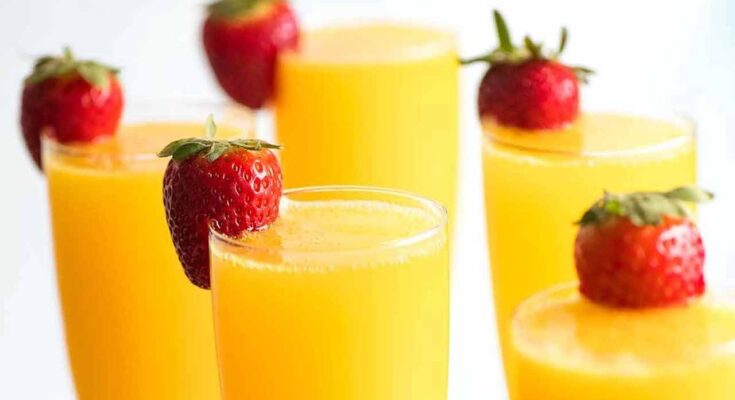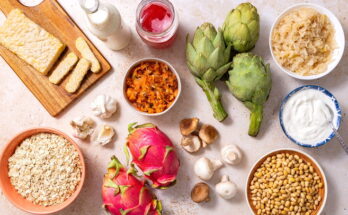Mimosa Recipe: Mimosas are the quintessential brunch drink, synonymous with celebrations, lazy Sundays, and indulgent gatherings. A delightful mix of champagne and orange juice, this simple yet elegant cocktail has found its way into hearts (and glasses) worldwide. But why are mimosas so loved?
Originating in France, mimosas were inspired by the citrus-and-bubbly cocktails of the roaring 1920s. Their name comes from the mimosa flower, whose bright yellow hue matches the drink’s vibrant color. Today, mimosas are a staple at brunch spots, bridal showers, and any occasion that calls for a toast.
Ingredients Required for a Mimosa
The Essential Ingredients
To make the perfect mimosa, you’ll need:
- Champagne or Sparkling Wine: Opt for a dry variety like Brut. Avoid overly sweet ones, as orange juice already provides sweetness.
- Fresh Orange Juice: For the best flavor, squeeze oranges yourself. Store-bought juice works but aim for pulp-free and unsweetened.
Optional Additions to Elevate Flavor
- Fruit Garnishes: Sliced strawberries, orange wedges, or raspberries add visual flair.
- Herbs: A sprig of mint or rosemary can transform the drink.
- Liqueurs: A splash of Grand Marnier or peach schnapps can create a more complex flavor profile.
Equipment You’ll Need
Basic Tools for Making Mimosas
- A Champagne Flute: The traditional choice for serving mimosas.
- Measuring Tools: A small measuring cup or jigger ensures accurate ratios.
- Juicer: If you’re using fresh oranges, a juicer will be your best friend.
Glassware Recommendations
While champagne flutes are classic, stemless flutes or coupe glasses work just as well. Opt for clear glass to showcase the vibrant hue of your mimosa.
Step-by-Step Instructions for Making a Classic Mimosa
Step 1: Chill Your Ingredients
Before you even start, ensure both your champagne and orange juice are thoroughly chilled. This keeps the drink refreshing and prevents diluting with ice (which is a big no-no in the world of mimosas!).
Step 2: Measure the Perfect Champagne-to-Juice Ratio
The classic mimosa ratio is 1:1, meaning equal parts champagne and orange juice. For a less citrusy drink, adjust to 2:1 in favor of champagne. Customize based on your preference.
Step 3: Pour Champagne First
Begin by filling half the champagne flute with champagne. Pouring the champagne first prevents the drink from becoming overly fizzy and mixing unevenly.
Step 4: Add Orange Juice
Slowly pour the orange juice into the glass until it reaches the desired level. Avoid stirring; the natural effervescence will mix the ingredients.
Step 5: Garnish for Presentation
Complete your mimosa with a slice of orange on the rim, a floating berry, or a sprig of fresh mint. Presentation elevates the experience and makes your drink Instagram-worthy!
Variations of the Classic Mimosa
Tropical Mimosa
For a beachy twist, swap out orange juice for pineapple juice. Add a splash of coconut water or coconut rum for an extra tropical vibe. Garnish with a wedge of pineapple or a maraschino cherry to complete the look.
Berry-Infused Mimosa
Love berries? Use cranberry juice, raspberry puree, or a mixed berry blend instead of orange juice. This variation is especially festive for holidays and special occasions. Add a few fresh berries to the glass for a pop of color.
Peach Bellini Mimosa
Inspired by the classic Italian Bellini, use peach nectar or puree instead of orange juice. The creamy, sweet flavor of peach pairs beautifully with dry champagne, creating a rich and luscious cocktail.
Tips for the Perfect Mimosa
Choosing the Right Champagne or Sparkling Wine
- Dry vs. Sweet: Opt for dry varieties like Brut or Extra Brut. Sweet options may overpower the balance.
- Champagne vs. Prosecco: Champagne is traditional, but Prosecco and Cava are affordable and equally delightful alternatives.
Best Juices to Use
- Freshly Squeezed: Nothing beats the vibrant taste of fresh orange juice.
- Pulp-Free: If you prefer a smoother drink, go for pulp-free juice.
- Exotic Options: Experiment with juices like mango, pomegranate, or grapefruit for a unique twist.
Dos and Don’ts for Mimosa-Making
- Do: Serve mimosas in chilled glasses for extra crispness.
- Don’t: Add ice; it dilutes the drink and ruins the texture.
- Do: Experiment with ratios to suit personal taste.
- Don’t: Overfill the glass—leave room for bubbles to expand.
Serving Suggestions
Pairing Mimosas with Food
Mimosas are versatile and pair well with:
- Breakfast Favorites: Think fluffy pancakes, buttery croissants, and omelets.
- Savory Dishes: Quiches, smoked salmon, and avocado toast balance the sweetness.
- Fruits and Desserts: Fresh fruit platters and light pastries complement the drink’s citrusy notes.
When to Serve Mimosas
Mimosas are perfect for:
- Brunch Gatherings: A staple for Sunday brunch.
- Celebrations: Ideal for weddings, baby showers, and birthday parties.
- Relaxation Days: Treat yourself on a lazy weekend or vacation morning.
Storing Leftover Ingredients
Storing Champagne
- Resealing the Bottle: Use a champagne stopper to keep the bubbles intact for up to 3 days.
- Chill Properly: Store the bottle in the refrigerator to maintain its crispness.
Keeping Juice Fresh
- Refrigeration: Store unused orange juice in an airtight container for up to 3 days.
- Avoid Freezing: Freezing alters the flavor and texture of fresh juice.
Frequently Asked Questions About Mimosas
Can I use Prosecco instead of Champagne?
Absolutely! Prosecco is a budget-friendly option that works wonderfully in mimosas. Its fruity notes pair beautifully with citrus juices.
What is the best ratio of champagne to juice?
The standard is 1:1, but feel free to adjust to 2:1 for a more champagne-forward drink or 1:2 if you prefer a stronger juice flavor.
Are mimosas only for brunch?
Not at all! While they’re brunch icons, mimosas are fantastic for evening celebrations, poolside lounging, or any special occasion.
Can I make non-alcoholic mimosas?
Yes! Substitute champagne with sparkling water, soda, or non-alcoholic sparkling wine for a refreshing virgin mimosa.
What are some creative garnish ideas
Try fresh herbs like basil or thyme, edible flowers, sugared rims, or exotic fruits like starfruit or passionfruit slices for a creative touch.
FAQs about Mimosa Recipe
1. What is a Mimosa?
A Mimosa is a classic cocktail made with equal parts of champagne and orange juice. It’s light, bubbly, and perfect for brunch or celebratory events.
2. What ingredients are needed to make a Mimosa?
To make a Mimosa, you’ll need:
- Champagne or sparkling wine
- Freshly squeezed orange juice (or store-bought juice for convenience)
- Optional: Garnishes like orange slices or fresh mint
3. What is the best champagne for a Mimosa?
While traditional champagne works great, you can use a more affordable sparkling wine like Prosecco or Cava. Aim for a dry (Brut) option to balance the sweetness of the orange juice.
4. Can I make a non-alcoholic Mimosa?
Yes! Simply substitute the champagne with sparkling water, club soda, or non-alcoholic sparkling wine for a refreshing mocktail version.
5. What is the ideal Mimosa ratio?
The standard ratio is 1:1, meaning equal parts champagne and orange juice. However, you can adjust it based on your preference for a stronger or lighter drink.
6. What occasions are perfect for serving Mimosas?
Mimosas are a staple at brunch, weddings, baby showers, or any festive gathering. They’re easy to prepare and add a touch of elegance to any event.
7. How do I keep Mimosas fresh when serving a crowd?
To serve a crowd, prepare a Mimosa bar with chilled champagne, a variety of fresh juices, and garnishes. Let guests mix their own for maximum freshness.
Conclusion
Making the perfect mimosa is as simple as it is rewarding. With the right ingredients, tools, and a touch of creativity, you can craft a drink that’s not only delicious but also a centerpiece for any gathering. Whether you stick to the classic recipe or experiment with exotic variations, mimosas are a delightful way to elevate your brunch or celebration.
So grab your champagne, juice, and a sunny spot to sip and savor your creation. Cheers to perfecting the art of mimosas!



